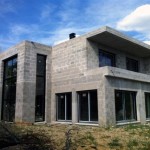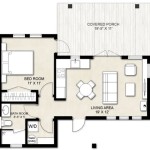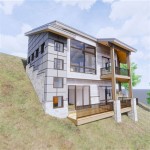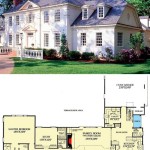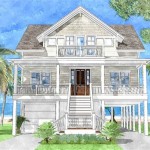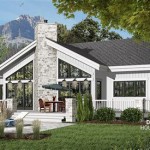Small Footprint House Plans refer to architectural designs for dwellings that prioritize space efficiency and environmental sustainability by minimizing the building’s footprint on the land. These plans typically feature compact layouts, optimizing available space through thoughtful design and clever use of multi-functional areas.
Small footprint homes are becoming increasingly popular due to their practicality and eco-friendliness. For instance, in urban areas where land is scarce, compact house plans offer an effective solution for maximizing living space while minimizing the environmental impact by reducing energy consumption and preserving natural resources.
In the following sections, we will explore the diverse range of small footprint house plans, their advantages and challenges, and provide insights into the key design elements that contribute to their functionality and appeal.
Here are nine important points about Small Footprint House Plans:
- Compact and efficient layouts
- Reduced environmental impact
- Lower energy consumption
- Increased affordability
- Multi-functional spaces
- Innovative storage solutions
- Natural lighting and ventilation
- Durable and sustainable materials
- Aesthetically pleasing designs
Small footprint house plans offer a range of benefits, including reduced construction and maintenance costs, energy efficiency, and a smaller environmental footprint.
Compact and efficient layouts
Compact and efficient layouts are a defining characteristic of small footprint house plans. By optimizing the use of space, these plans maximize living areas while minimizing the overall footprint of the building. Here are four key points to consider:
- Open floor plans: Open floor plans eliminate unnecessary walls and partitions, creating a more spacious and cohesive living environment. This approach allows for seamless flow between different functional areas, making the most of the available space.
- Multi-functional spaces: Multi-functional spaces serve multiple purposes, maximizing the utility of each room. For example, a living room can also function as a dining area or a guest room, eliminating the need for dedicated spaces.
- Built-in storage: Built-in storage solutions, such as shelves, drawers, and cabinets, are incorporated into the design to minimize clutter and maximize space utilization. These storage options are often cleverly concealed within walls, under stairs, or in other unused areas.
- Vertical space utilization: Small footprint house plans often make use of vertical space through features such as lofts, mezzanines, and built-in bunk beds. These elements add extra living space without increasing the footprint of the building.
By incorporating these design strategies, small footprint house plans achieve a high level of space efficiency, ensuring that every square foot is utilized effectively.
Reduced environmental impact
Small footprint house plans contribute significantly to reducing the environmental impact of residential buildings. Here are four key points to consider:
1. Reduced energy consumption: Smaller homes require less energy to heat, cool, and light, resulting in lower energy consumption and reduced greenhouse gas emissions. Compact designs and efficient layouts minimize heat loss and maximize natural light, further reducing the need for artificial lighting and heating.
2. Sustainable materials: Small footprint house plans often prioritize the use of sustainable and eco-friendly materials, such as recycled content, renewable resources, and low-VOC (volatile organic compound) materials. These materials have a lower environmental impact during extraction, production, and disposal.
3. Smaller carbon footprint: The reduced size and energy efficiency of small footprint homes result in a smaller carbon footprint. This is a measure of the total greenhouse gas emissions associated with a building over its lifetime, including construction, operation, and maintenance.
4. Land preservation: By minimizing the footprint of the building, small footprint house plans help preserve natural habitats and reduce urban sprawl. This contributes to the conservation of biodiversity and the maintenance of healthy ecosystems.
Overall, small footprint house plans offer a more sustainable approach to residential living, reducing energy consumption, promoting the use of eco-friendly materials, minimizing the carbon footprint, and preserving natural resources.
Lower energy consumption
Small footprint house plans are designed to minimize energy consumption through a combination of passive and active strategies. Here are four key points to consider:
1. Reduced heat loss: Compact designs and efficient layouts minimize the surface area exposed to the external environment, reducing heat loss through walls, windows, and doors. Additionally, insulation is carefully placed to prevent heat transfer and maintain a comfortable indoor temperature.
2. Passive solar design: Passive solar design principles are incorporated to maximize natural heat gain during winter and minimize heat gain during summer. This involves carefully orienting the building to take advantage of sunlight, using windows to capture heat, and incorporating thermal mass to store and release heat as needed.
3. Energy-efficient appliances and systems: Small footprint house plans often prioritize the use of energy-efficient appliances and systems, such as LED lighting, ENERGY STAR-rated appliances, and high-efficiency HVAC systems. These measures reduce energy consumption without compromising comfort or functionality.
4. Renewable energy sources: Small footprint house plans can be integrated with renewable energy sources, such as solar panels and geothermal systems, to further reduce reliance on fossil fuels and promote sustainable living.
By implementing these strategies, small footprint house plans achieve lower energy consumption, resulting in reduced utility bills and a smaller environmental footprint.
Increased affordability
Small footprint house plans offer several advantages that contribute to increased affordability, making them accessible to a wider range of homebuyers. Here are four key points to consider:
- Reduced construction costs: Smaller homes require less materials and labor to build, resulting in lower construction costs. This is particularly advantageous in areas with high land and labor costs.
- Lower property taxes: The assessed value of a property is typically based on its size and value. Since small footprint homes have a smaller footprint and value, they often have lower property taxes, reducing the ongoing cost of homeownership.
- Reduced energy bills: As discussed earlier, small footprint homes are designed to be energy-efficient, resulting in lower utility bills. This can lead to significant savings over the lifetime of the home.
- Lower maintenance costs: Smaller homes generally require less maintenance and upkeep compared to larger homes. This is because there is less space to clean, fewer appliances and systems to maintain, and a smaller roof and exterior to care for.
Overall, small footprint house plans offer increased affordability by reducing construction costs, lowering property taxes, minimizing energy bills, and decreasing maintenance expenses.
Multi-functional spaces
Multi-functional spaces are a defining characteristic of small footprint house plans. By maximizing the utility of each room, these plans create versatile and adaptable living environments. Here are four key points to consider:
- Living-dining-kitchen areas: Open floor plans combine the living room, dining room, and kitchen into one cohesive space. This creates a sense of spaciousness and allows for multiple activities to occur simultaneously, such as cooking, dining, and socializing.
- Bedrooms with multiple uses: Bedrooms can be designed to serve multiple functions, such as a guest room, home office, or playroom. Built-in furniture, such as Murphy beds or fold-down desks, can be incorporated to maximize space utilization.
- Flexible spaces: Rooms can be designed to be flexible and adaptable to changing needs. For example, a room can be used as a den during the day and converted into a guest room at night.
- Storage-integrated spaces: Storage can be cleverly integrated into multi-functional spaces, such as under-bed drawers, built-in shelves, and hidden compartments. This helps to keep spaces organized and clutter-free.
By incorporating multi-functional spaces, small footprint house plans create adaptable and efficient living environments that meet the diverse needs of modern households.
Innovative storage solutions
Small footprint house plans often incorporate innovative storage solutions to maximize space utilization and maintain a clutter-free environment. Here are four key points to consider:
1. Built-in storage: Built-in storage is seamlessly incorporated into the design of the home, utilizing spaces that would otherwise go unused. This includes features such as under-stair storage, built-in shelves and drawers, and hidden compartments. By integrating storage into the structure of the home, valuable floor space is freed up.
2. Multi-purpose furniture: Multi-purpose furniture serves multiple functions, providing both storage and utility. For example, ottomans with built-in storage can be used for seating and storing blankets or pillows. Beds with built-in drawers or headboards with shelves provide additional storage space without taking up extra floor area.
3. Vertical storage: Vertical storage solutions make use of the vertical space in a room to maximize storage capacity. This includes installing floating shelves, utilizing vertical organizers, and hanging baskets on walls. By storing items vertically, valuable floor space is preserved.
4. Smart storage systems: Smart storage systems utilize innovative mechanisms to optimize storage space. This includes features such as roll-out shelves, pull-out drawers, and lazy Susans. These systems allow for easy access to stored items and maximize the use of available space.
By incorporating these innovative storage solutions, small footprint house plans create efficient and organized living environments, ensuring that every square foot is utilized effectively.
Natural lighting and ventilation
Small footprint house plans prioritize natural lighting and ventilation to create healthy, comfortable, and energy-efficient living environments. Here are four key points to consider:
Maximizing natural light
Windows and skylights are strategically placed to maximize natural light penetration, reducing the need for artificial lighting during the day. Large windows and sliding glass doors connect the interior to the outdoors, creating a sense of spaciousness and bringing the outdoors in. Light-colored walls and reflective surfaces are used to bounce light around the interior, further enhancing natural illumination.
Promoting natural ventilation
Natural ventilation is encouraged through the use of cross-ventilation, where windows and vents are positioned on opposite sides of the home to allow air to flow through. This helps to circulate fresh air, remove stale air, and regulate indoor temperature. Passive ventilation techniques, such as solar chimneys and wind towers, can also be incorporated to enhance natural ventilation.
Energy efficiency
Natural lighting and ventilation contribute to the energy efficiency of small footprint homes. By reducing the reliance on artificial lighting and air conditioning, energy consumption is lowered. Additionally, natural ventilation helps to maintain a comfortable indoor temperature, reducing the need for heating and cooling systems.
Health and well-being
Natural lighting and ventilation have a positive impact on the health and well-being of occupants. Natural light has been shown to improve mood, boost productivity, and regulate sleep-wake cycles. Fresh air ventilation helps to reduce indoor air pollution, creating a healthier indoor environment. By incorporating natural lighting and ventilation into their designs, small footprint house plans promote the physical and mental well-being of their inhabitants.
In conclusion, small footprint house plans embrace natural lighting and ventilation as essential elements for creating sustainable, healthy, and comfortable living spaces. By maximizing natural light penetration, promoting natural ventilation, and utilizing energy-efficient strategies, these plans contribute to the well-being of occupants while reducing the environmental impact of residential buildings.
Durable and sustainable materials
Small footprint house plans prioritize the use of durable and sustainable materials to ensure longevity, resilience, and environmental friendliness. By incorporating these materials into their designs, these plans aim to minimize the environmental impact of residential buildings and create healthy and comfortable living spaces.
- Recycled and renewable materials:
Small footprint house plans often incorporate recycled and renewable materials, such as reclaimed wood, bamboo, and recycled glass, to reduce their environmental impact. These materials help conserve natural resources, reduce waste, and promote sustainability.
- Low-VOC materials:
Volatile organic compounds (VOCs) are harmful chemicals that can be emitted from building materials and furnishings. Small footprint house plans prioritize the use of low-VOC materials, such as paints, adhesives, and sealants, to create a healthier indoor environment and reduce the risk of respiratory problems.
- Durable and resilient materials:
Durable and resilient materials, such as fiber cement siding, metal roofing, and engineered wood products, are used in small footprint house plans to withstand harsh weather conditions and minimize the need for frequent repairs and replacements. These materials contribute to the longevity of the home and reduce the environmental impact associated with material extraction and production.
- Energy-efficient materials:
Energy-efficient materials, such as insulated concrete forms (ICFs) and triple-glazed windows, are incorporated into small footprint house plans to reduce energy consumption and create more comfortable living environments. These materials help to regulate indoor temperature, minimize heat loss, and contribute to the overall energy efficiency of the home.
By utilizing durable and sustainable materials, small footprint house plans promote environmental sustainability, create healthier indoor environments, and enhance the overall resilience and longevity of residential buildings.
Aesthetically pleasing designs
Small footprint house plans prioritize not only functionality and sustainability but also aesthetic appeal. By incorporating thoughtful design elements and incorporating the surrounding environment, these plans create visually stunning homes that blend seamlessly into their surroundings.
- Clean lines and simple forms:
Small footprint house plans often embrace clean lines and simple forms to create a modern and minimalist aesthetic. This approach emphasizes the essential elements of the design, resulting in a visually pleasing and timeless look.
- Natural materials and textures:
Natural materials and textures, such as wood, stone, and glass, are frequently used in small footprint house plans to create a connection to the outdoors and bring warmth and character to the home. These materials add visual interest and depth, enhancing the overall aesthetic appeal.
- Large windows and outdoor spaces:
Large windows and outdoor spaces are incorporated into small footprint house plans to maximize natural light and create a sense of openness. These elements blur the boundaries between indoors and outdoors, providing stunning views and enhancing the overall livability of the home.
- Landscaping and hardscaping:
Landscaping and hardscaping play a crucial role in the aesthetic appeal of small footprint house plans. Thoughtful placement of trees, shrubs, and other greenery, along with the integration of patios, decks, and walkways, creates a cohesive and inviting outdoor environment that complements the architectural design.
By combining these design elements, small footprint house plans create aesthetically pleasing homes that are both functional and visually captivating. These homes blend seamlessly into their surroundings, reflecting the beauty of nature and enhancing the overall quality of life for their occupants.










Related Posts


